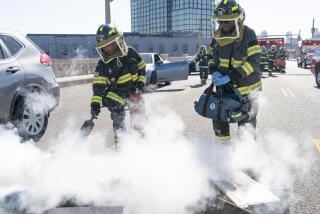Is Real TV Getting a Bit Too Real?
- Share via
Twenty years ago, the movie “Network” satirized television by depicting programs featuring on-air murders and prime-time psychics. Based on recent trends, some people wonder if that fictional past has become our present.
Several programs relying on real video footage of death and destruction--among them the Fox specials “When Disaster Strikes” and “When Animals Attack”--have prompted some discussion within the TV industry about boundaries of taste. What may be more telling, however, is that viewers don’t appear overly concerned, registering few complaints and watching such shows in big numbers.
Indeed, both Fox specials drew extremely good ratings, the latter setting the network’s record for any non-sports program in the 7 p.m. Sunday hour. Similarly, CBS did inordinately well with two installments of “World’s Most Dangerous Animals” (a third is awaiting an airdate), while one of the few new shows making waves in syndication is the video-compilation program “Real TV,” which airs weekdays locally on KCAL-TV Channel 9.
“When Disaster Strikes” featured segments showing people leaping to their deaths from a burning high-rise, a fatal helicopter collision and a plane crash. The latest “When Animals Attack,” which will repeat next Monday, includes graphic footage of people mauled by bears, bitten by sharks and even pummeled by an enraged deer, plus a circus elephant attacking and killing its trainer. Such images were seen extensively in on-air promos during afternoon football telecasts.
Media critics and even some industry executives bemoan the content of such programs. “We would never air anything like that,” said NBC West Coast President Don Ohlmeyer, who has contended before that Fox gets away with more lax standards than the other networks. “That’s the stuff that gives all of us a bad name.”
NBC, in fact, took considerable heat four years ago by airing a series called “I Witness Video” that at times featured footage of disasters and fatal events. The program (ordered prior to Ohlmeyer’s arrival) ran one season before declining viewership, coupled with a glut of negative press, ultimately resulted in its cancellation.
The UCLA Center for Communication Policy also singled out the animal specials in its latest study of television violence, calling the trend “ominous” and the programs “just showcases for exploitative video footage of people being attacked and occasionally killed.”
Center director Jeff Cole maintains that these specials are “the equivalent of auto-accident programming on network television” that could terrify children.
Although the same video footage airs within newscasts, critics cite a distinction between news and entertainment specials that employ dramatic reenactments, music and slow-motion to heighten the sense of excitement. Some have gone so far as to compare the programs to “Faces of Death,” a controversial video showing people dying in various ways.
Fox had no official comment regarding the specials, but a network source noted that few if any viewer complaints were received. The specials do carry a parental-discretion advisory.
The producers of “When Disaster Strikes” acknowledge that they faced a juggling act trying to make a point about the numbing effect of seeing deadly images in TV news while still exercising proper restraint.
“I think the feeling was this kind of footage is viewed constantly on local news and national news,” said producer Jean-Michel Michenaud. “All of the images on the show have been on TV many times before. When we see it in the context of news, it means nothing. . . . We have become desensitized to it. We were trying to re-sensitize people to this footage.”
Fox’s “When Animals Attack” and CBS’ “World’s Most Dangerous Animals” have much in common. Both presented some of the same video and used music, dramatizations, actual footage and interviews with survivors. They also preached a respect-nature message, though some critics see that as merely a means of justifying the video imagery.
“Dangerous Animals” producers Erik Nelson and Dave Bell also insist that questions of propriety come down to context.
“We took great pains in our specials to walk the line between ratings and responsibility,” Nelson said. “To me it’s like the difference between romance and pornography. . . . It’s really the producers’ responsibility.”
In addition, the producer suggests that scenes of violence involving animals are perhaps less objectionable than atrocities committed by people.
Cole disagreed, saying real-looking re-creations and graphic video can be more disturbing than obvious fantasy. “In some ways this is much scarier to kids,” he said. “This is about as real as it gets.”
The producer of “Real TV” stressed that his program is designed as pure entertainment, offering a wide variety of video with no reenactments and music added sparingly.
“We think that ‘Real TV’ is as pure as a program of this type can be in terms of presenting that footage unadulterated. I think that makes a difference in the mind of the audience,” said executive producer Ron Vandor.
“We’re not out to shock anybody,” he added, noting that a mere handful of nearly 500 segments thus far have been deemed graphic enough to warrant an on-air advisory. “If the show was all-disaster, all the time, there comes a point where you become desensitized to it, and that is a legitimate concern.”
Some worry that, as in “Network,” these video-based programs will have to become increasingly salacious to keep titillating an audience. Others say that, practically speaking, there isn’t enough footage to support many programs of this type, and even if there were, the novelty will wear off given television’s cyclical nature.
“It’s a frightening trend,” Nelson said, “[but] I think it’s going to burn itself out, as they all do.”
More to Read
The complete guide to home viewing
Get Screen Gab for everything about the TV shows and streaming movies everyone’s talking about.
You may occasionally receive promotional content from the Los Angeles Times.






